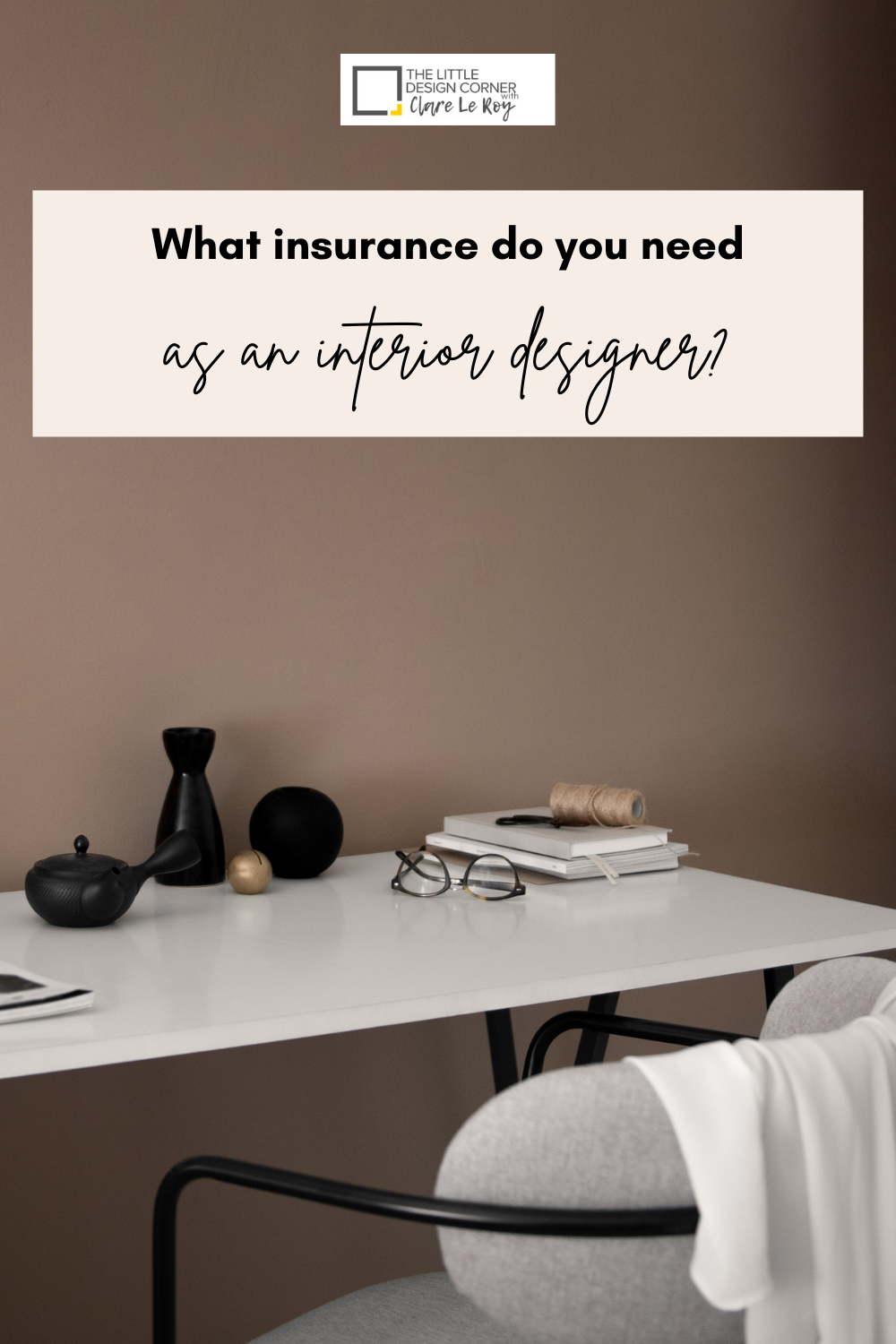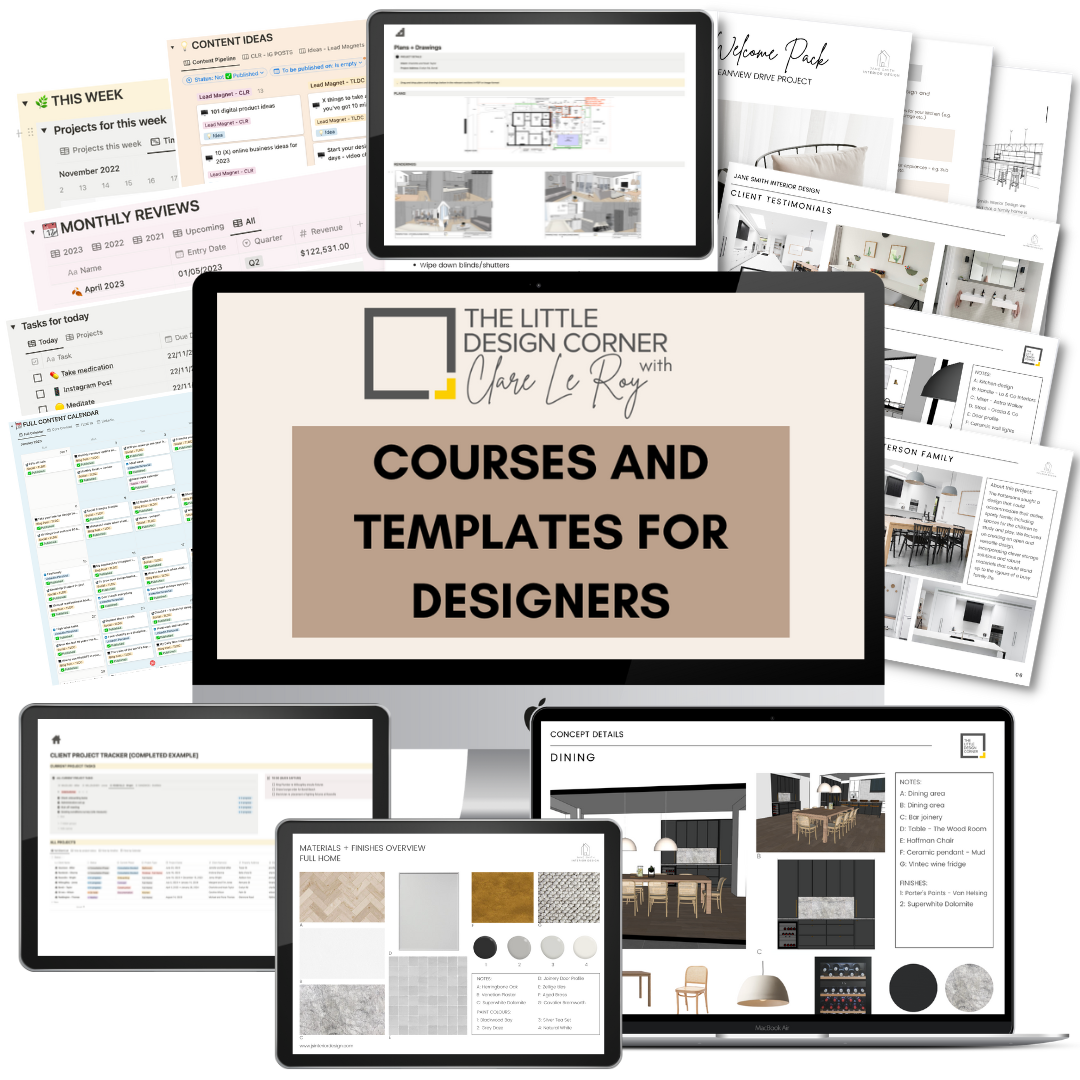What insurance do you need as an interior designer?
In this post let’s take a look at one of the topics that scares lots of design professionals when they first start out in business – insurances.
Before we start I want to remind you that I am not a lawyer, accountant or insurance specialist.
The topics I cover in this post are for information only and based on my own experience as an Australian designer and should not be relied on as a substitute for advice from a qualified and licensed insurance broker, lawyer or accountant in your local jurisdiction.
Insurance is about risk mitigation
At the end of the day insurance is largely about risk mitigation. You pay an insurance premium in order to cover your business if something goes wrong.
The aim of this post is to help you understand a bit about the risks involved in running your business and provide you with some preliminary information so you can ask the right questions when you seek advice from an insurance broker, which I strongly suggest you do.
When I first started my business I put my head in the sand about insurance.
It all seemed overwhelming and I figured what I was doing wasn’t too risky, so I just decided not to worry about it. But as my business got more complicated and the work I was doing was more risky – in terms of potential mistakes or problems costing me a lot of money to fix up – I decided I needed to try and understand more about insurance and what I needed.
But at that time I had no idea where to go to seek help with insurance and couldn’t work out the difference between the different types of insurance that were out there and whether or not I needed them.
So this post is designed to give you an overview of the main types of insurance so that you can approach an insurance broker with enough knowledge to have an intelligent and informed discussion with them.
What type of insurance does a designer need?
When it comes to insurances each design business will have different requirements depending on a range of factors such as
what type of business you run (e.g. decorating has far less risk attached than large scale commercial work or architectural work),
how much revenue you are generating,
whether you have employees
your appetite for risk in relation to the running of your business.
Finding the right level of insurance cover for your particular business and your unique circumstances is one of the important ways of managing the risk associated with doing business.
Be aware that (in Australia at least) there are both compulsory and non-compulsory insurances required for doing business and that these vary by location and type of business.
Some are required by law, while others are required by industry bodies or as part of doing business as a contractor. So make sure you know the different required insurances for where you are conducting business and the sort of business you run. An insurance broker will help you with this.
In my experience many design professionals find the area of insurance worrying and confusing.
They aren’t quite sure where to start nor where to go for help. As a result many are operating businesses with no insurance at all and just close their eyes about it and hope that they don’t run in to any trouble. Or on the flip side I find others who have levels of insurance cover that really is unnecessary for the type of work they do and the sort of risk that is involved. This means the risk is covered, but these designers are paying massive amounts for insurance premiums that aren’t necessary for the level of risk in their business.
So you want to find that balance between the two of these extremes – and think about your tolerance for risk and indeed the level of risk involved in the type of work you will be doing.
I strongly suggest you seek advice from an insurance broker on the matter of insurances – they know the industry best and will ask you questions about your individual business situation and tailor an insurance policy that suits your individual circumstances.
The price you will pay for an insurance policy will be based on the type of services you offer and your annual business turnover.
But so that you can go into a conversation with an insurance broker informed about your options, I will briefly go through some of the main types of insurances you will want/need to consider in your business. Keep in mind there are other types of insurance besides these, but these are the main ones that will be important for design professionals to consider:
Workers compensation
Profession indemnity
Public liability
Income protection
Workers Compensation
This is compulsory if you have employees or are paying yourself as an employee
Professional Indemnity
This covers you in relation to claims made against you by clients as a result of alleged negligence in your professional advice or services rendered.
Examples might include errors in your design work and mistakes you might make (e.g. accidentally sign off on an incorrect paint colour). This also covers situations where your client has suffered a financial loss and is looking to recover all or part of it from you.
Public Liability
This covers you in relation to claims made against you for property loss or damage or personal injury.
This one is a must for those who have their own office space or for those who plan on running things like workshops or meet ups where you will be hosting people/clients in public spaces, but is also important for designers working individually. For example, if you accidentally damage your client’s property whilst visiting their home or office.
Income Protection
This would be important if you or your family are relying on the income you are generating from your business. It covers you in certain circumstances for periods where you are not able to work.
You may also need to consider insurance for delivery or storage of goods or for freight, if this has been arranged by you (i.e. not being delivered by the supplier). Also, if you plan to manufacture products or sell, distribute or import products then you should also consider product liability insurance for this.
Products purchased from suppliers
Suppliers should have their own insurances for faulty products, even if recommended by you.
But check with your insurance broker on this and seek advice on whether or not you are exposed to risk by recommending products that are later found to be substandard or inappropriate for your selected use. Examples might be tiles that are installed and later found to be the incorrect slip rating (e.g. you were told it had a certain slip rating or have documentation about this but later someone slips and falls and it is found you were told something incorrect), taps that you were told/have documentation saying would be appropriate for outside use but then go rusty after a few months – scenarios like that.
Do you really need insurance?
Overall be sensible about your insurances.
Consider the level of work you do and the risk it exposes to you if you had to pay to rectify mistakes. Professional indemnity will be helpful if you are working with decisions that could be costly to fix and you don’t want to pay out of your own pocket. If you’re just choosing cushions and inexpensive furniture or accessories as your primary service then you should consider what insurance is worth paying for (as your risk is obviously lower in this situation).
But don’t put your head in the sand about insurance.
You don’t want to risk working in areas you are not covered for or exposing yourself to unnecessary risk that you could resolve quickly and easily via a phone call. Ultimately please seek further advice from an insurance broker and discuss your own unique situation.
Working with an insurance broker
I suggest you shop around for insurance and find one who has experience with the design industry.
I also think it’s a good idea to get a number of quotes for insurance as the quotes and premiums tend to be different from my experience. Plus you will learn a lot by having the same conversation with a number of different brokers.
When talking to your insurance broker and arranging your insurance be sure to be very specific and honest when advising them of what services you are performing and who you are performing them for.
To ensure you are covered, you need to make sure you let them know what you do, who your clients are (e.g. residential only, large scale commercial, etc), and whether you offer other services as well (e.g. if you’re licensed to offer project management services). That way they can then make sure that your policy does not contain any exclusions or restrictions that would render you uninsured in the event of a claim.
The main message of this post:
There are a lot of risks associated with working as a designer and architect and the more complicated the work you do, the more risk you are exposed to.
Take insurance seriously and talk to some insurance brokers so you understand what compulsory and non-compulsory you need.
You are then in a position to understand what the costs of your insurances might be, the risks you have and which insurance is worth paying for based on your risk tolerance.
Courses and Templates for Designers and Architects
DO YOU WANT TO….
Improve your professionalism?
Find more clients?
Bring in more revenue?
Create better systems and processes?
Then check out my business courses and templates for designers and architects.
These courses and templates leave you with work done - not just a long list of things you need to do next. We have a really strong focus on taking action and getting things created that improve your business.
Enjoy the rest of your day!
Clare x
Dr Clare Le Roy








